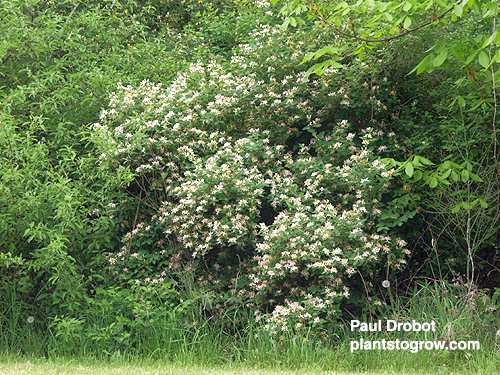| Description | Honeysuckle (Lonicera) is an overplanted shrub that has escaped into natural areas and becomes a woody, noxious weed. It should not be used! |
|---|---|
| Pronunciation | (lon-ISS-er-a) |
| Plant Type | All Plants, Shrubs Deciduous |
| Hardiness Zone | 3-8 |
| Sunlight | full to shade |
| Moisture | average, adaptable |
| Soil & Site | average, adaptable |
| Flowers | red, pink to white and produced in large numbers in the early spring, fruit is a soft berry; red to orange and it can persist on the shrub into the fall, birds eat this fruit and have spread it into native areas. |
| Leaves | opposite, simple and bluish green in color. Honeysuckle leaf out early in the spring, shading out native plant material. The shrub has been attacked by the Russian aphid. This causes the terminal branches to become contorted. Another reason to avoid this shrub like the plague |
| Stems | brown, matures into a very distinct bleached tan color, this makes the plant easy to id in the winter landscape, |
| Dimensions | A very large shrub reaching 10 by 10 or greater. I just observed a large old (at least 20 years) Honeysuckle hedge being removed. The plants were way over 12' tall and the stumps diameter was at least 8-10". |
| Propagation | don't!!!!!!!!!!!!! |
| Native Site | Found in central Asia to Russian. |
| Misc Facts | First used in 1752 as an ornamental and to provide food and shelter for wildlife. |
| Author's Notes | It can't be overemphasized that this shrub is an ecological pest. I have seen old mature plants over 12 feet tall with equal spread. The trunks must have had an 8-inch or greater diameter. As one of the faculty advisors for the Students To Save The Earth club, I cut down and pulled thousands of small plants from natural areas. |
| Notes & Reference | #01-Manual of Woody Landscape Plants (Michael Dirr), #55-The Garden Book for Wisconsin (Melinda Myers), #274-Site Authors' observations and growing experiences |

Cart












